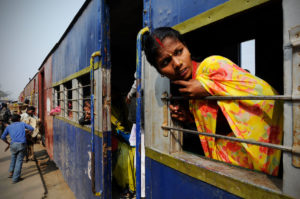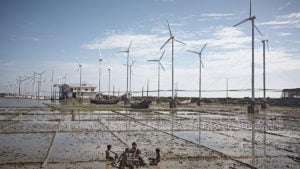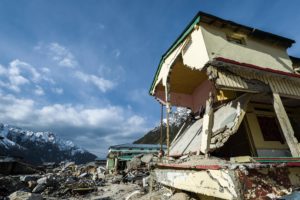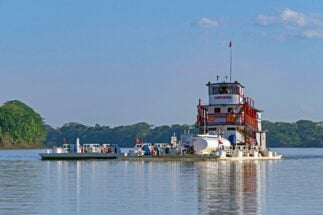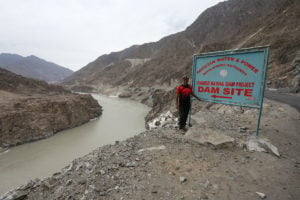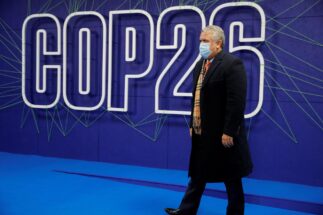In September 2020, Nepal bought two diesel-powered trains from India. Three months later, it submitted its second Nationally Determined Contribution (NDC) to the United Nations, a pledge to cut greenhouse gas emissions and adapt to the changing climate that every country needs to submit under the Paris Agreement.
One of the targets in Nepal’s NDC is to develop 200 kilometres of electric railway network by 2030. However, the country has less than 100 kilometres of railways, and the first trains to run on these tracks will be the two diesel trains bought from India. (There are currently no trains in operation in Nepal.)
Conflicting actions
“A major problem with our policy documents is that different institutions within the government perform conflicting actions,” said Prashanta Khanal, an environmental activist and advocate of sustainable transport. “Buying first diesel [trains] and sending a document to the UN with a plan to develop 200 kilometres of electric railways at the same time is one of many such examples.”
In its first NDC, submitted to the UN in 2016, Nepal pledged to “increase the share of electric vehicle up to 20% by 2020”, and expand renewable energy by 20% by 2020. But when it submitted the second NDC last year, the share of renewable energy in the country’s portfolio was about 3%. Electric vehicles accounted for around 1% of the market, according to the revised NDC document.
Meanwhile, the overall consumption of fossil fuels has risen sharply over the past four years, with gasoline use doubling. This has sustained the country’s explosive growth that was only briefly halted by the Covid-19 pandemic. Currently, Nepal is extending its petroleum pipelines from India and building more storage facilities.
Big promises in Nepal’s NDC, missed targets
Though none of the energy-related pledges laid out in the first NDC have been met, the updated commitment has even more ambitious figures and claims. It aims for 15% of total energy to come from “clean energy sources” – a 400% increase.
400%
Pledged increase in renewable energy in Nepal between 2020 and 2030 set out in the revised NDC
“I agree it’s an ambitious plan, but we should understand that NDCs need to be ambitious, and we should work to meet the targets if we want to keep the world below 1.5 degrees of warming,” said Radha Wagley, head of the climate change management division at the Ministry of Forests and Environment.
However, she agreed with Khanal that cooperation between different ministries has been poor, and said she hoped that will change. “It’s true that collective efforts are lacking, but we should challenge business as usual and work together to meet the targets set by our NDC,” Wagley added.
It’s an ambitious plan, but we should understand that NDCs need to be ambitiousRadha Wagley, Ministry of Forests and Environment
Emissions increase, despite climate pledge
Although Nepal’s contribution to global greenhouse gas emissions remains negligible at 0.027% of the total, it grew from 26 to 54 metric tonnes of CO2-equivalent between 1990 and 2016, according to the research group Climate Action Tracker. “While the government is showing some progress in the implementation of its mitigation policies, under current policies, emissions are expected to increase between 31-36% by 2030 above current levels,” the site says.
The second NDC has set a target to increase electric vehicle sales to 90% of private passenger vehicles, including two-wheelers, by 2030. It also states 60% of all sales of public passenger vehicles on four wheels will be electric by the end of the decade.
“These figures look good but how do you involve the private sector, which currently holds over a billion US dollars worth of investments, effectively dominating the public transport sector?” asked Umesh Raj Shrestha, president of the Electric Vehicle Association of Nepal. “Without a programme to encourage businesses to switch to electric mobility, we won’t meet the NDC’s transport targets.”
While the NDC aims to reach net-zero greenhouse gas emissions by 2050, data from the customs department of the Ministry of Finance shows another reality. According to a report published in 2019, the country’s most imported commodity is diesel, with petrol, liquefied petroleum gas (LPG) and coal all in the top 10. Data released by the Global Carbon Atlas showed that Nepal’s per capita emissions increase is the highest in South Asia. Between 2016 and 2017 per capita emissions increased by 5%, 10 times more than the global average of 0.5%.
Mitigation over adaptation
Some argue that Nepal’s NDC focuses only on mitigation and lacks the adaptation plans that the country is in dire need of. “Government and donors who prepared the NDC drew upon a standard template used by developed nations, with special focus on carbon mitigation, but Nepal’s real need is adaptation,” said Prabin Man Singh, programme director at the Prakriti Resources Centre, an NGO that works on sustainable development and environmental justice in Nepal. “There could have been balance between adaptation and mitigation, as Bangladesh has done, but we failed to cash [in] on that opportunity.”
The revised NDC is an ad hoc document and very unlikely to be successfully implementedPrashanta Khanal, environmental activist
Khanal, the activist and sustainable transport advocate, argues that while adaptation should be prioritised, “mitigation is not just about reducing carbon emissions, but also reaping co-benefits in terms of public health and social equity.”
Khanal said that ultimately the debate between mitigation and adaptation is semantic, and instead questions Nepali institutions’ capacity to implement any commitment. “It’s OK to have these documents but where is the programme to realise the plan? How would you manage finance?” he said. “For example, truck transport is the major carbon emitter within the mobility sector, but it’s not mentioned in the NDC.” The pledge, he said, “is an ad hoc document and very unlikely to be successfully implemented”.
Loss and damage dilemma
As COP26 approaches, pressure to raise the issue of loss and damage is mounting in the country. Sher Bahadur Deuba, Nepal’s prime minister, will attend the event in Glasgow and many expect him to demand compensation for climate-induced disasters, since the country is experiencing increasingly disruptive extreme weather.
The latest such disaster occurred in June in the Melamchi valley, 40 kilometres northeast of capital Kathmandu. A large flood wreaked havoc on towns and cities, killing six people and leaving 20 missing. Hundreds of homes were washed away and the country’s largest water supply project delivering drinking water to the capital was impacted.
Ngamindra Dahal, chair of the Nepal Water Conservation Foundation and a climate change expert, said: “This event is clearly an impact of climate change, and we should use this and other cases as evidence [to make a case for compensation] at the UN conference in Glasgow.”
Loss and damage has been a contentious issue for decades, and the UN still does not have an official definition for it. Initially raised by a group of small island countries in 1991, the issue has never established an official goal within the UN climate negotiations, as developed nations are not willing to commit to financial support beyond what is needed for adaptation.
“Scientists have attributed many events to climate change following some standard methodologies, mostly in the Global North but also in some cases in South Asia,” said Sunil Acharya, regional adviser of climate and resilience at Practical Action, a development charity. “Unfortunately, we don’t yet have any such study conducted in Nepal so far. However, we can use some simple indicators to claim attribution to start with.”
Proving the climate link
According to recent research, nearly 10,000 people have been killed by extreme weather events in Nepal in the past three decades. Two-thirds of the casualties recorded were due to floods and landslides, with the rest caused by thunderstorms, cold waves, windstorms, snowstorms, heatwaves and hailstorms. “We need further analysis, but we can already see that the increase in extreme weather events has caused a spike in disaster-related deaths in Nepal,” said Dipesh Chapagain, climate change researcher at the University of Bonn in Germany.
According to government agencies, the country’s annual maximum temperature is increasing by 0.056 degrees Celsius per year. The average temperature is predicted to rise by 0.92-1.07Cin the medium term, up to 2045, and 1.30-1.82C in the long term, by 2065.
[The floods in Melamchi were] clearly an impact of climate change, and we should use this and other cases as evidence [to make a case for compensation] at the UN conference in GlasgowNgamindra Dahal, Nepal Water Conservation Foundation
The issue of compensation for climate-related disasters “is definitely a priority, but we don’t have enough research and data to [connect the disasters Nepal is facing to climate change and] make a case for loss and damage,” said Radha Wagley from the Ministry of Forests and Environment.
However, she added, it is important that the international community eventually reaches consensus on what constitutes loss and damage, and connects this theoretical description with disasters such as those happening in Nepal. To aid the process, she said, “one major activity planned under our NDC is to conduct more research where we lack appropriate information on how climate change drives extreme weather.
